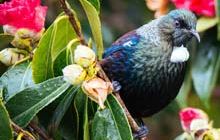Tomtit/miromiro
Introduction
The New Zealand tomtit looks similar to a robin. They are a small bird with a large head, a short bill and tail, and live in forest and scrub.There are five subspecies of tomtit (Petroica macrocephala), each restricted to their own specific island or island group: North Island, South Island, the Snares Islands, the Chatham Islands and the Auckland Islands.
The Māori name of the North Island tomtit is miromiro, while the South Island tomtit is known as ngirungiru.
New Zealand status: Endemic
Threats: Predation
Species information: Tomtit/miromiro on NZ Birds Online
Image gallery
-
Tomtitngirungiru on Stewart Island/Rakiura Image: Graham Commins | Creative Commons
![Tomtit on Stewart Island. Tomtit on Stewart Island.]()
-
North Island tomtit/miromiro Image: Shellie Evans ©
![North Island tomtit. North Island tomtit.]()
-
South Island tomtit/ngirungiru Image: Sabine Bernert ©
![South Island tomtit. South Island tomtit.]()
-
South Island tomtit/ngirungiru Image: Sabine Bernert ©
![South Island tomtit. South Island tomtit.]()
Facts
- Although the New Zealand tomtit belongs to the Australasian robin family of birds it is not a robin.
- The tomtit is a small bird, about 13 cm long.
- They have large heads and short bills.
- The North Island and South Island subspecies of tomtits are smaller than their off-shore island relatives, weighing in at around 11 g. Birds from Snares Island can weigh almost twice as much as this (normally 20 g).
- The male North Island subspecies is distinctly black and white, with a black head, back, wings (with a white wing bar) and a white belly.
- The subspecies from the South Island, the Chatham Islands and Auckland Islands are similar, but have a distinctly yellow breast
- The Snares Island subspecies is entirely black.
- Each tomtit pair may raise up to three broods during a season, from September to January.
Sound recordings
Chatham Island tomtit song (MP3, 1,549K)
01:43 – Adult male in Glory Bay, Pitt Island, Chatham Islands.
North Island tomtit song (MP3, 2,808K)
02:59 – In mixed forest near Mount Bruce.
South Island tomtit song (MP3, 1,440K)
01:31 – Adult male South Island tomtit on Rabbit Island, Nelson.
Our bird songs can be reused, even commercially, according to our copyright terms.
Threats
Tomtit populations were susceptible to massive land clearances earlier in European settlement and are still vulnerable to mammalian predators.
Populations have stabilized to some extent and they can be found in mature exotic plantations with abundant native understory.
Our work
Tomtit are not threatened, so DOC doesn't actively work with them.
Of course, the work that DOC does in plant and animal pest control increases the quality of whole ecosystems, and therefore contributes to the ongoing success of many common birds, such as the tomtit, as well as ensuring the ongoing survival of our rarer more susceptible species.
DOC priorotises its work to protect the rarer species, in the context of their overall environment. This is encapsulated in the whakatauki (Maori Proverb):
"Tiakina nga manu, ka ora te ngahere Ka ora te ngahere, ka ora nga manu"
"Look after the birds and the forest flourishes. If the forest flourishes, the birds flourish."
You can help
Emergency hotline
Call 0800 DOC HOT (0800 362 468) immediately if you see anyone catching, harming or killing native wildlife.
On your property
- Trap predators on your property.
- Be a responsible cat owner.
In your community
- Find and volunteer with your local community group
- Trap predators in your community
- Get kids or schools involved
See Predator Free 2050 Trust - get involved for information.
Visiting parks, beaches, rivers, and lakes
- Leave nesting birds alone.
- Use available access ways to get to the beach.
- Avoid leaving old fishing lines in the water.
- Follow the water care code and local navigation bylaws.
- Do not drive on riverbeds, or keep to formed tracks if you have to.
- Check for pests if visiting pest-free islands.
With your dog
- Only take dogs to areas that allow them, and keep them under control.
- If you come across wildlife put your dog on a lead and lead it away.
- Warn other dog owners at the location.
- Notify DOC if you see wildlife being harassed by people or dogs.
- Get your dog trained in avian awareness.
- Learn about the Lead the Way programme which encourages dog owners to become wildlife wise and know how to act to protect coastal wildlife.
Specific ways to keep wildlife safe while with your dog on beaches.





